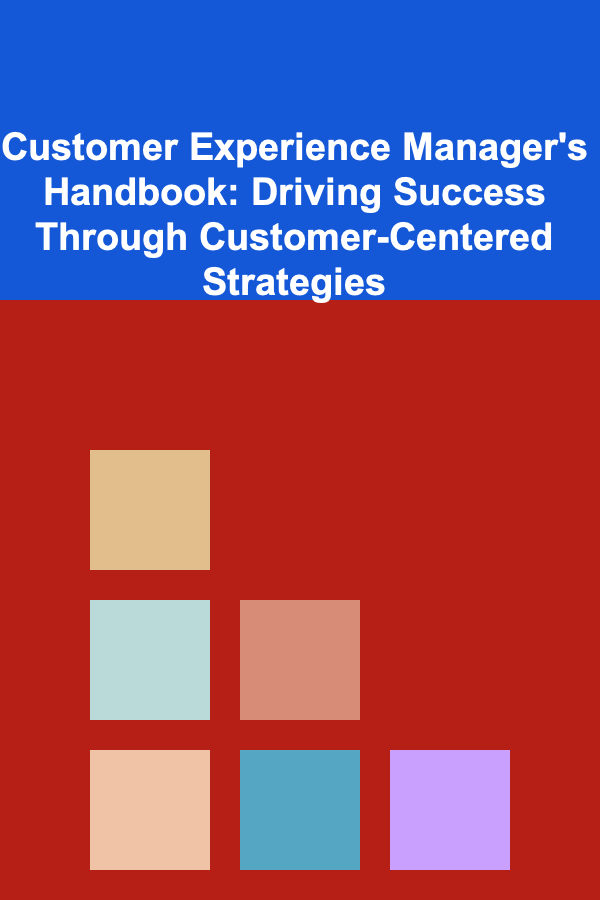
Customer Experience Manager's Handbook: Driving Success Through Customer-Centered Strategies
ebook include PDF & Audio bundle (Micro Guide)
$12.99$8.99
Limited Time Offer! Order within the next:

In the current business landscape, customer experience (CX) is the linchpin of competitive differentiation. As customers have become more informed and expect more personalized interactions, the role of a Customer Experience Manager (CXM) has evolved into one of the most critical functions in an organization. A CXM is tasked with shaping the overall customer journey, optimizing every touchpoint, and ensuring that every interaction is a positive reflection of the brand.
The path to delivering exceptional customer experiences is both complex and rewarding. This actionable guide will provide you with insights and strategies to excel in the role of a Customer Experience Manager. By embracing a customer-centered approach, utilizing data-driven insights, and fostering a customer-centric culture, you can drive success for your organization while enhancing customer satisfaction and loyalty.
Defining the Role of a Customer Experience Manager
A Customer Experience Manager is responsible for overseeing the entire customer journey from start to finish, ensuring that every interaction a customer has with the brand is seamless, enjoyable, and aligned with the company's values. While the role may vary depending on the organization, the CXM generally leads efforts to:
- Enhance customer interactions across all channels (in-person, online, phone, etc.)
- Design and implement customer-centered strategies that reflect the needs and preferences of customers
- Monitor customer satisfaction metrics and feedback to identify areas for improvement
- Coordinate cross-departmental initiatives to create a cohesive and consistent customer experience
The CXM acts as both a strategist and a leader, influencing not only the customer service department but also marketing, product development, and sales. They must bridge the gap between customer expectations and business goals, ensuring that both are met without compromising on either.
Building a Customer-Centered Strategy
Creating a customer-centered strategy is the foundation of a successful customer experience. This strategy must be aligned with the company's mission, vision, and goals while being adaptable to ever-evolving customer needs. As a CXM, your role is to lead the development and execution of this strategy.
Step 1: Understand the Customer Journey
Before developing a strategy, it's essential to fully understand the customer journey. The journey spans all the stages a customer goes through before, during, and after interacting with your brand. These stages typically include:
- Awareness: The customer learns about your brand.
- Consideration: The customer evaluates your offerings and compares them to competitors.
- Purchase: The customer makes a buying decision and completes the transaction.
- Post-Purchase: The customer engages in post-purchase interactions, such as support, feedback, or follow-up.
By mapping out the customer journey in detail, you can identify pain points, opportunities for improvement, and moments that matter most. This process should involve collecting insights from customer data, such as surveys, interviews, and behavioral analytics, as well as input from frontline staff who interact directly with customers.
Step 2: Set Clear Customer-Centric Goals
Once you understand the customer journey, set specific and measurable goals that align with both customer needs and business objectives. These goals should focus on improving customer satisfaction, loyalty, and overall experience. Some common CX goals include:
- Reducing customer churn by improving retention strategies
- Enhancing customer satisfaction (CSAT) scores and Net Promoter Scores (NPS)
- Increasing customer lifetime value (CLV) through better engagement and upsell strategies
- Improving first-call resolution in customer service interactions
Ensure that these goals are realistic and achievable while being challenging enough to drive progress. Aligning CX goals with broader business objectives, such as revenue growth or market expansion, will ensure that your strategy is viewed as a crucial component of the company's overall success.
Step 3: Integrate Feedback Loops
Feedback loops are essential in the customer experience ecosystem. Regularly collecting feedback from customers allows you to measure satisfaction and identify areas for improvement. Use a variety of feedback methods, such as:
- Surveys: Post-interaction surveys and long-term customer satisfaction surveys are crucial for capturing detailed feedback.
- Customer Interviews: Conduct one-on-one interviews with customers to dive deeper into their experiences and pain points.
- Social Listening: Monitor social media channels for mentions of your brand to capture unsolicited feedback.
- Customer Reviews: Reviews on third-party sites or your own website can provide valuable insights into customer sentiment.
As you gather feedback, it's important to analyze it regularly, spot trends, and adjust your strategy accordingly. This will help you stay agile and responsive to customer needs.
Step 4: Foster a Customer-Centric Culture
A customer-centered strategy cannot be successful without a strong, company-wide commitment to customer experience. As a CXM, it's your responsibility to lead by example and foster a customer-centric culture that permeates every department in the organization. This requires aligning employees with the vision of delivering outstanding customer experiences and embedding this ethos into the company's values.
How to Foster a Customer-Centric Culture:
- Lead by Example: Demonstrate a customer-first mindset in all your actions. Encourage your team to do the same by modeling behaviors like active listening, problem-solving, and empathy.
- Employee Training: Provide ongoing training that equips your team with the skills they need to deliver exceptional customer service. Focus on key areas such as emotional intelligence, communication, and conflict resolution.
- Cross-Department Collaboration: Work with teams across the organization, including marketing, sales, and product development, to ensure that customer experience is a shared responsibility. Hold regular meetings to discuss customer feedback and align on initiatives.
- Recognize and Reward: Celebrate team members who go above and beyond to deliver excellent customer experiences. Rewarding exceptional performance helps reinforce the importance of customer experience throughout the organization.
Step 5: Leverage Technology to Enhance CX
In today's digital age, technology is a powerful ally in delivering personalized and efficient customer experiences. As a CXM, it's essential to leverage the right tools to streamline customer interactions and improve the quality of service. Some key technologies to consider include:
- Customer Relationship Management (CRM) Systems: A robust CRM system allows you to track customer interactions, preferences, and history, enabling more personalized experiences.
- Omnichannel Support: Provide a consistent experience across all channels---phone, email, chat, social media, and in-person. Use integrated systems to ensure that your team can deliver seamless support regardless of the platform.
- Chatbots and AI: Implement AI-powered chatbots for handling routine customer inquiries. These tools can provide instant responses, reduce wait times, and allow your team to focus on more complex issues.
- Data Analytics: Leverage customer data to gain insights into behavior, preferences, and trends. Use this information to make informed decisions, predict customer needs, and optimize your CX strategy.
Driving CX Success Through Continuous Improvement
Customer experience is not a one-time project but an ongoing process of improvement. As a CXM, you must establish a continuous feedback loop to ensure that your strategy remains relevant and effective. Here are some strategies for driving continuous improvement:
Regularly Review KPIs and Metrics
Monitor key performance indicators (KPIs) such as CSAT, NPS, and customer retention rates to track the success of your CX strategy. Use these metrics to identify areas where your team is excelling and areas that need attention. Regular reviews help you stay on track and ensure that you're delivering the desired outcomes.
Experiment and Innovate
Don't be afraid to experiment with new ideas and innovative approaches. Whether it's testing new communication channels, launching loyalty programs, or improving website usability, innovation plays a key role in enhancing the customer experience. Conduct A/B testing to measure the impact of changes and refine your strategies accordingly.
Stay Informed and Adapt
The world of customer experience is always evolving, and new technologies, trends, and customer expectations emerge constantly. Stay informed by attending CX conferences, reading industry blogs, and networking with other CX professionals. This will help you stay ahead of the curve and adapt your strategy to changing market conditions.
Conclusion: The Power of Customer-Centered Strategies
As a Customer Experience Manager, your ultimate goal is to create exceptional, memorable experiences that drive customer satisfaction, loyalty, and advocacy. By building a customer-centered strategy, fostering a customer-first culture, leveraging technology, and continuously improving based on feedback, you can elevate the experience your organization offers. Remember, the success of your company is tied to the success of your customers---when you put their needs first, you drive success for both them and your business.

How to Archive Family Heirlooms for Future Generations
Read More
How to Set Up a Cozy Family Reading Corner for Quiet Time
Read More
How to Store Seasonal Items in Shared Spaces
Read More
How to Use Motion-Activated Cameras for Home Security
Read More
Mastering Technical Analysis for Trading: A Comprehensive Guide
Read More
How To Paint Abstract Art: Unleash Your Creativity
Read MoreOther Products

How to Archive Family Heirlooms for Future Generations
Read More
How to Set Up a Cozy Family Reading Corner for Quiet Time
Read More
How to Store Seasonal Items in Shared Spaces
Read More
How to Use Motion-Activated Cameras for Home Security
Read More
Mastering Technical Analysis for Trading: A Comprehensive Guide
Read More